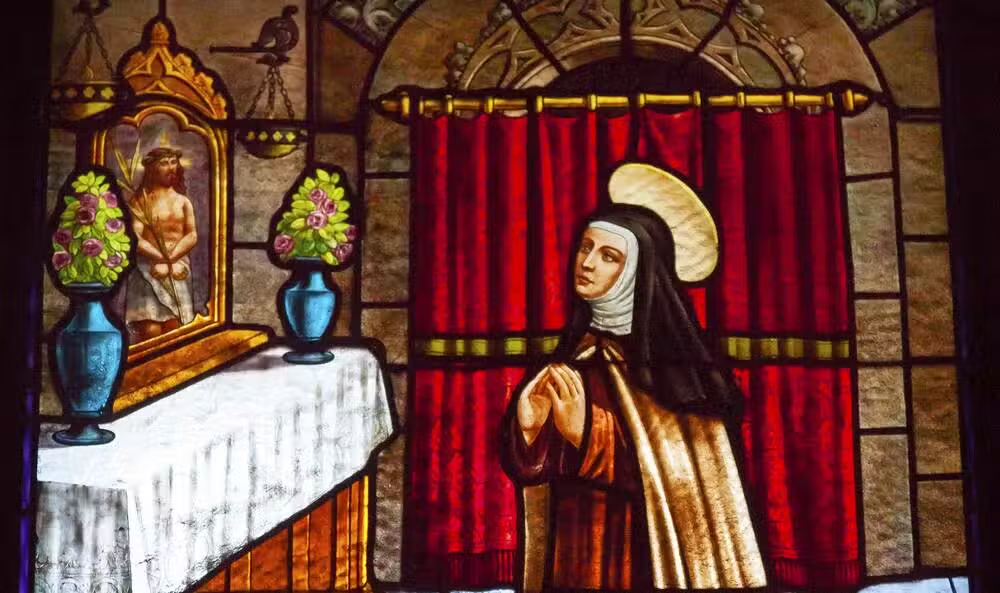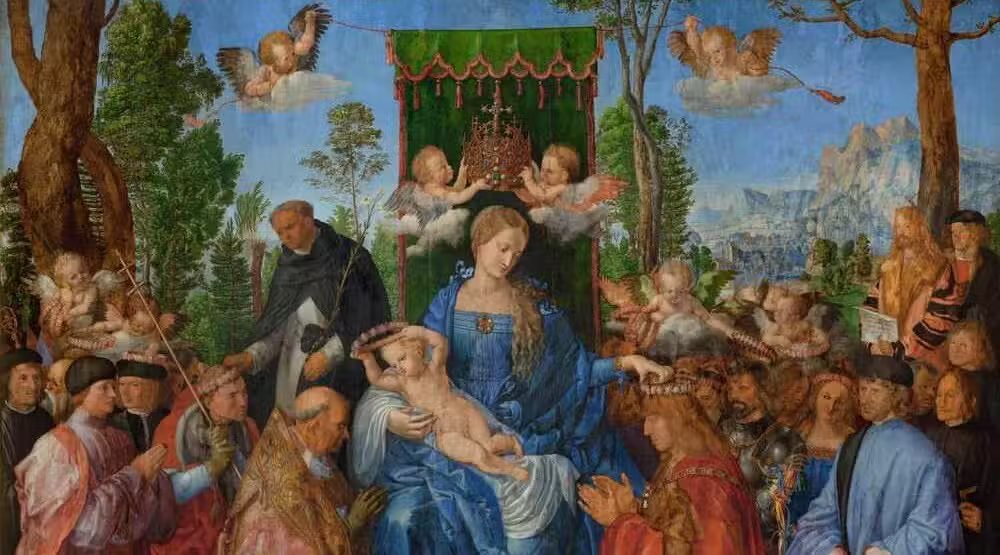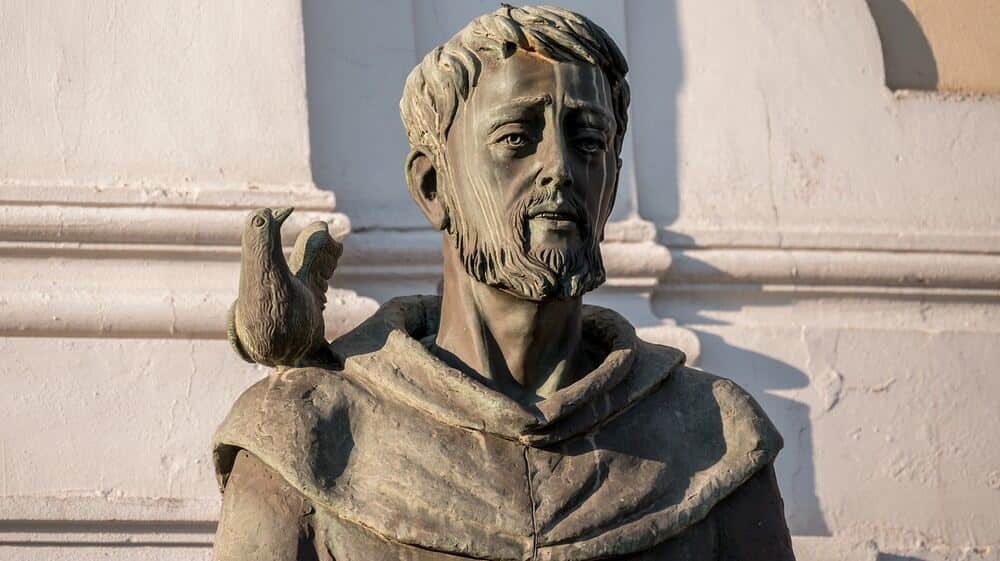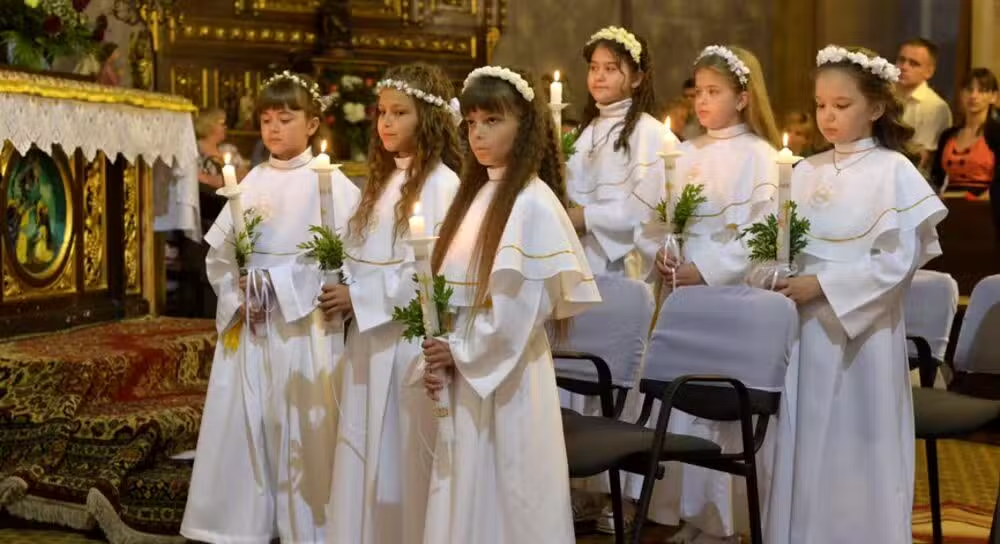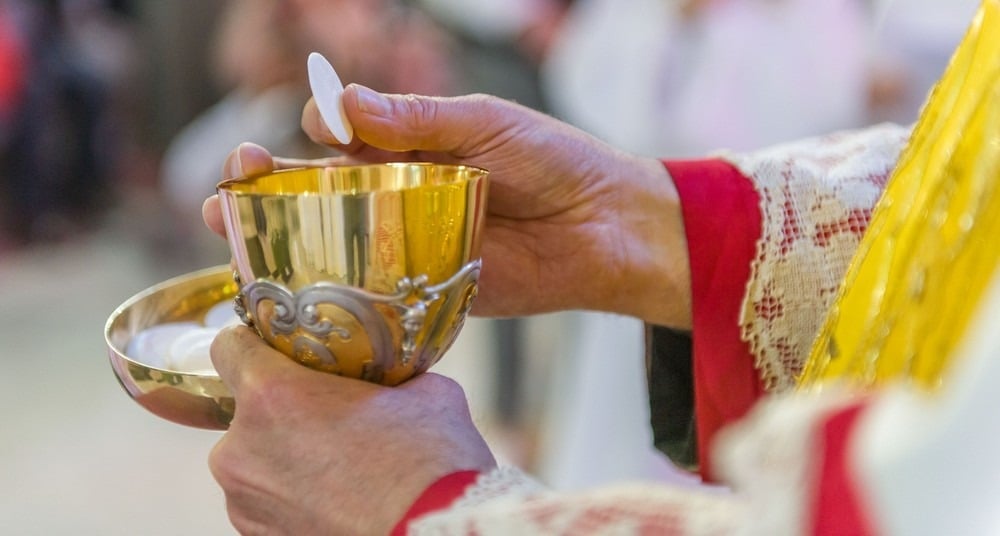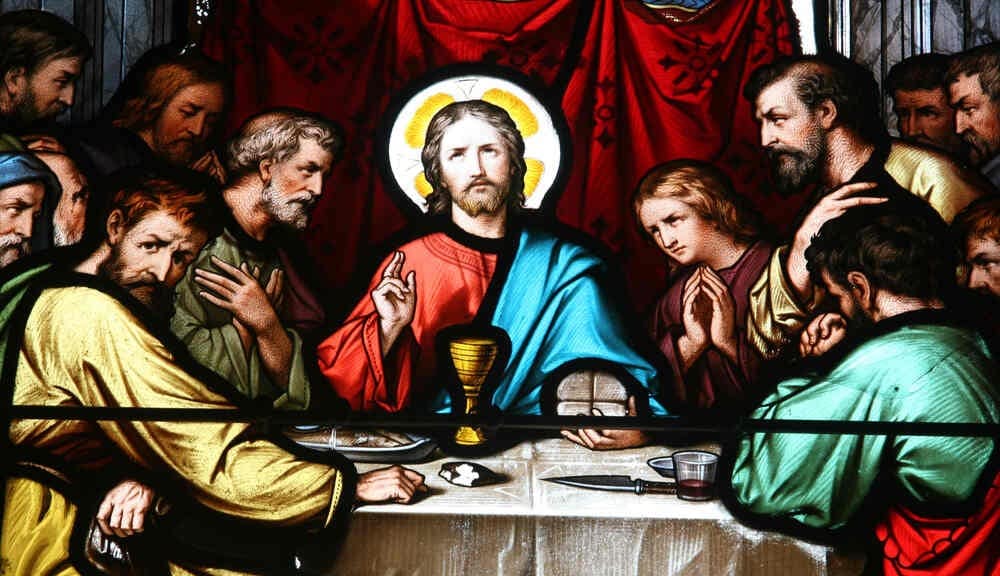Do you know the story of the first woman ever declared as a Doctor of the Church? Saint Teresa of Jesus (also known as Saint Teresa of Ávila) was a nun, founder of the Discalced Carmelites, a mystic, and a Spanish writer. Alongside Saint John of the Cross, she is regarded as one of the great teachers of spiritual life.
You might wonder: what could a cloistered Carmelite nun possibly teach someone living in the modern world? The answer lies in her own life. Saint Teresa lived with great passionly, struggled with her own weaknesses (as we all do), and allowed herself to be transformed by the love of God. That is the secret of holiness: letting yourself be loved and shaped by Him.
Below, we share five impressive anecdotes from her life, along with some reflections on the Eucharist and prayers that sprang from her heart. May you find in Saint Teresa of Jesus not only inspiration, but also a friend, an intercessor, and a guide who leads you to be transformed by the love of God.
Stories of Saint Teresa
Her Childhood Games
Saint Teresa was born into a deeply Christian family. She was the third of twelve children. Her parents were devout and God-fearing. Her father loved to read pious books. Her mother taught her to pray and to love the Blessed Virgin and the saints.
She was especially close to one of her brothers, nearly her own age. Together they would read the lives of the saints. Inspired by the example of the martyrs, who bought eternal joy at so small a price, they wished to die like that.
We agreed to go to the land of the Moors, begging for the love of God, so that they would behead us there.
According to tradition, they were found by their uncle, Francisco Álvarez de Cepeda, at a place called The Cross of the Four Posts, and brought home, where they received a stern reprimand.
The thought of eternity left a lasting impression on her. With her brother, she would often repeat:
Forever, forever, forever!
When they realized martyrdom wasn’t possible, they decided to become hermits. In their garden, they tried to build little hermitages out of stones — which kept falling down.
With her friends, Teresa also loved to “play nuns” and pretend they were founding convents. Even as a child, she carried that longing in her heart.
The Miracle of Saint Joseph
En su adolescencia, Santa Teresa de Jesús perdió a su madre, y con ella comenzó también a desdibujarse la virtud que había cultivado desde niña. Se aficionó a los libros de caballerías, a los que dedicaba largas horas en lo que ella misma llamó un “vano ejercicio”. Poco a poco, empezó a buscar la vanidad: se preocupaba por los adornos, el cuidado de las manos y del cabello, y deseaba agradar a todos.
Lo que más daño le hizo fue la mala compañía, especialmente unos parientes que la introdujeron en las vanidades del mundo. Su padre, para apartarla de los peligros de esa mala vida, decidió llevarla a un convento donde se criaban seglares, cuando tenía apenas doce años.
En el internado de Santa María de Gracia, Santa Teresa vivió un fuerte combate interior que la llevó a tomar una decisión definitiva: ser religiosa. Le pareció el camino más seguro para salvarse. Sin embargo, cuando expresó su deseo de ingresar al Carmelo de La Encarnación, su padre se opuso. Santa Teresa de Ávila, decidida, se fugó de casa, aunque con mucho dolor. Tenía veinte años.
En 1537 profesó como carmelita, pero al poco tiempo cayó gravemente enferma. La familia, alarmada, la puso en manos de una curandera famosa, cuyo tratamiento empeoró su estado. Sufrió un “paroxismo” que la dejó sin sentido durante casi cuatro días, y se pensó que no sobreviviría. En un punto se la dio por muerta.
Tras una recuperación parcial —porque quedó postrada durante 3 años—, afirmó que San José la había curado. Lo tomó como abogado.
Vi claro que así de esta necesidad como de otras mayores de honra y pérdida de alma este padre y señor mío me sacó con más bien que yo le sabía pedir. No me acuerdo hasta ahora haberle suplicado cosa que la haya dejado de hacer.
Es cosa que espanta las grandes mercedes que me ha hecho Dios por medio de este bienaventurado Santo, de los peligros que me ha librado, así de cuerpo como de alma; que a otros santos parece les dio el Señor gracia para socorrer en una necesidad, a este glorioso Santo tengo experiencia que socorre en todas y que quiere el Señor darnos a entender que así como le fue sujeto en la tierra -que como tenía el nombre de padre, siendo ayo, le podía mandar-, así en el cielo hace cuanto le pide.
- You might be interested in: The Life of Saint Teresa of Jesus
The Image of the “Wounded Christ”
Despite her miraculous healing, Saint Teresa of Ávila continued to live tepidly, distant from God. Because she was very charming, she spent long hours in the convent parlor, conversing with visitors and benefactors. As a result, she neglected her spiritual life and the practice of virtue.
Even though she had received warnings about the harm she was doing to herself, she could not decide to change her ways—until, after twenty years of what she called “such a painful war,” she finally converted.
One day, upon entering the oratory, One day, upon entering the oratory, she saw an image of a “very wounded Christ.” The image represented so vividly the suffering of Christ for us that Saint Teresa was deeply moved by her own ingratitude:
:
It seemed to me that my heart was breaking.
She threw herself at the feet of the image, begging Him to strengthen her once and for all so that she would no longer offend Him. From that moment on, she never again abandoned her life of prayer and began to advance rapidly in her spiritual journey.
The Transverberation
After this conversion, the Lord began to grant her ever greater spiritual graces. Once, she saw a small angel, very beautiful, with a face burning with light. In his hands he held a long golden dart with a bit of fire at the tip. The angel pierced her heart. Saint Teresa recounts:
When he drew it out, it seemed to me he was drawing my entrails with it, and he left me all afire with a great love of God. The pain was so great that it made me utter several moans; and yet so surpassing was the sweetness of this excessive pain that I could not wish to be rid of it. The soul is satisfied with nothing less than God.
Saint Teresa of Jesus did not feel physical pain, but a spiritual one. From that moment, the only thing she desired was to live entirely for the Lord.
- You might be interested in: Book of Relations
The Descent into Hell
Many years later, Saint Teresa had a vision of hell. She describes it as follows:
After the Lord had already granted me many of the favors I have mentioned and others of even greater magnitude, one day while in prayer I suddenly found myself—without knowing how—in what seemed to be hell itself. I understood that the Lord wanted me to see the place the devils had prepared for me there, and which I had deserved by my sins. It lasted only a brief moment, but even if I were to live many years, I think it would be impossible to forget it. I understood that the Lord wanted me to see the place the devils had prepared for me there, and which I had deserved by my sins. It lasted only a brief moment, but even if I were to live many years, I think it would be impossible to forget it
She experienced the torment of the condemned souls, consumed by the inner fire of despair. She understood that the Lord wanted to show her what He had spared her from. Saint Teresa of Jesus also learned to endure suffering patiently, knowing that it would lead her to Heaven. Moreover, she felt deep sorrow for the souls that are lost. For this reason, she resolved to save as many souls as she could. From then on,
I desired to flee from people and to withdraw completely from the world
Saint Teresa of Ávila decided to live according to the original Carmelite rule and, inspired by God, left the Convent of the Incarnation to found the first monastery of Discalced Carmelite nuns, dedicated to Saint Joseph.
Quotes of Saint Teresa of Jesus about the Eucharist
The Eucharist was Saint Teresa’s greatest love. Through Holy Communion and Eucharistic Adoration, she advanced in her spiritual life, received abundant graces, and lived supernatural experiences.
In moments of deep affliction or inner trial, she often found rest “immediately after receiving Communion” or even simply “upon reaching the Blessed Sacrament,” where she felt that “all the darkness of the soul is dispelled,” and she became “completely healed, soul and body.” Once, after receiving Communion, the Lord sat beside her, consoled her, and showed her His wounds, saying: “You are not without Me. Life passes quickly.” Many times, the Lord reproached her after Communion when Saint Teresa doubted His work.
In the Blessed Sacrament, Saint Teresa grasped the “greatness of God hiden in something so small as the Host.” Seeing her own ingratitude in the face of the tenderness and love of the Lord in the Sacrament, she felt unworthy to receive “that most glorious Body, full of purity and mercy.”
Once, during Communion, she saw two demons in a “most abominable form” and it seemed to her that “the horns encircled the throat of the poor priest.” Yet, at the same time, she saw Christ in the Host she was going to receive. The Lord explained that He had allowed this so that she might understand “the power that the words of consecration have” and how God does not cease to be there “no matter how bad the priest is.” This vision gave her a profound knowledge of the goodness of God, who places Himself “in the hands of his enemy.”
When she faced great difficulties, Saint Teresa of Jesus felt that her greatest consolation in her suffering was to know that in the monastery “the Lord was to be praised and and the Blessed Sacrament adored.” The first thing she sought when founding a convent was to have Jesus in the Sacrament because “since Jesus Christ, true God and true Man, is present in the Blessed Sacrament in so many places, it ought to be a great comfort to us.“.
At the foundation of the convent in Valladolid, the Lord told her that the soul of the benefactor knight would not leave purgatory “until the first Mass was said there.” When she was receiving Holy Communion, the knight appeared to her “with a radiant and joyful face,” thanking her because he had been released from purgatory.
On one occasion, as she was about to receive Communion and the Host had not yet been given to her, Saint Teresa saw “something like a dove fluttering its wings with a soft sound” above the Eucharist in the tabernacle.
Saint Teresa of Jesus loved to receive Communion in a large host. One day, Saint John of the Cross, who was celebrating Mass, broke the Host to give half to another sister. She thought she would not receive the whole Lord and was saddened. Jesus told her not to be afraid—that no one could take Him away from her, even if she received only a small piece of the Host. He gave her His right hand and said:
Behold this nail, a sign that from this day you shall be My spouse. Until now you have not deserved it; from now on, you will look to My honor not only as your Creator, your King, and your God, but as My true spouse: My honor is now yours, and yours is Mine.
- You might be interested in: The Way of Perfection
Prayers of Saint Teresa of Ávila
Saint Teresa has many prayers written in her works. Here we share some fragments of her poems:
The Soul’s Desire
I LIVE, but yet I live not in myself
For since aspiring to a life more high
I ever die because I do not die.
The mystic union of Love divine,
The bond whereby alone my soul doth live
Hath made of God my Captive – but to me
True liberty of heart the while doth give
And yet my spirit is so sorely pained
At gazing on my Lord by me enchained
That still I die because I do not die[…]
Life, what can I give
to my God who lives in me,
if it is not to lose you,
to deserve to win him?
I want to reach him dying,
for so much I love my Beloved,
that I die because I do not die.
Self-Oblation
Lord, I am Thine, for I was born for Thee!
Reveal what is it Thou dost ask of me.
Lo, I am Thine! Thou hast create me:
And I am Thine, Thou hast redeemed me:
And I am Thine, for Thou dost bear with me,
And Thine, for Thou hast called me to Thee,
And Thine, Who dost preserve me at Thy cost
Nor leavest me to perish ‘mid the lost-
Say what it is, Lord, Thou dost will of me. […]
Behold my heart, which here I bring, and in
Thine hand as glad entire free offering lay,
Together with my body, life, and soul,
The love, the longings that my being sway!
To Thee, Redeemer and most gentle Spouse,
In willing holocaust I pledge my vows,
What is there, Lord, that I may do for Thee?
Bestow long life, or straightway bid me die;
Let health be mine, or pain and sickness send,
With honour or dishonour; be my path
Beset by war, or peaceful till the end.
[…]
Divine Beauty
O Beauty, that doth far trascend
All other beauty! Thou doest deign,
Without a wound, our hearts to pain –
Without a pang, our wills to bend
To hold all love for creatures vain.
O mystic love-knot, that dost bind
Two beings of such diverse kind!
How canst Thou, then, e’er servered be?
For bound, such strength we gain from Thee,
We take for joys the griefs we find!
Things void of being linked, unite
With that great Beauty Infinite:
Thou fill’st my soul, which hungers still:
Thou lov’st where men can find but ill:
Our naught grows precious by Thy might!
Saint Teresa’s Bookmark
Let naught disturb thee;
Naught fright thee ever;
All things are passing;
God changeth never.
Patience e’er conquers;
With God for thine own
Thou nothing dost lack-
He sufficeth alone!
- You might be interested in: Poems of Saint Teresa
The Teachings of Saint Teresa
What can we learn from Saint Teresa? Her life has left us many lessons.
From a young age, Saint Teresa desired to become a saint because she read the lives of the saints, longed to imitate them, and made every effort to do so.
Often, it is necessary to distance ourselves from friendships that lead us down the path of sin.
Doing God’s will is the first step towards sanctification. Many times, answering His call is painful—very painful. Saint Teresa of Ávila experienced this. But afterward, there comes a greater peace and joy of heart from obeying the Lord, who always desires what is best for us. She never doubted her vocation and was always very happy in her religious life.
She trusted Saint Joseph blindly. Saint Teresa of Jesus turned to him in all her needs. Of all the saints, after the Blessed Virgin Mary, he is the most powerful intercessor before Jesus Christ, for he remains His adoptive father in Heaven, and Jesus continues to obey him with love.
We must use our talents for the greater glory of God—to lead souls to Him—not to feel admired or loved by others.
Saint Teresa knew she was drifting away from God because she neglected her prayer life and the practice of virtue by becoming too absorbed in worldly matters. She felt this pain deeply. She struggled within herself to convert. Yet her conversion was granted to her by grace. We must beg for the grace of our own conversion—for the ability to see our miseries and correct ourselves—but always by placing prayer first.
Like Saint Teresa, we should grieve for the many souls who have turned away from God and make every effort to lead as many as we can to Heaven.
Who is Saint Teresa of Avila?
Saint Teresa of Jesus, also known as Saint Teresa of Ávila, was a Carmelite nun, mystic, writer, and religious reformer born in Ávila, Spain, in 1515. She is recognized as one of the great figures of Christian spirituality and was the first woman proclaimed a Doctor of the Church for her profound teaching on the interior life and prayer.
Founder of the Order of Discalced Carmelites, she dedicated her life to renewing the Carmelite order, promoting a more austere life, centered on prayer, poverty, and fraternity. Throughout her life, she wrote fundamental works such as The Book of Her Life, The Way of Perfection, and The Interior Castle, in which she shares her mystical experiences and her journey of union with God.
When is Saint Teresa's Feast Day?
The feast day of Saint Teresa of Jesus is celebrated on October 15.
What is the Difference between Saint Thérèse and Saint Teresa?
Although both are Carmelite saints and Doctors of the Church, Saint Teresa of Jesus (Ávila) lived in the 16th century and was a reformer of the Carmelite order, a mystic, and a founder of convents. In contrast, Saint Thérèse of the Child Jesus (Lisieux) lived in the 19th century, was a cloistered Carmelite, and is known for her “little way” of spiritual childhood, humility and trust in God.
How many Saint Teresas are there in the Catholic Church?
There are several saints named Teresa, but the most well-known are:
- Saint Teresa of Jesus (Ávila): Doctor of the Church and reformer of the Carmelite order.
- Saint Thérèse of the Child Jesus (Lisieux): Patroness of the missions and also a Doctor of the Church.
- Saint Teresa Benedicta of the Cross (Edith Stein): Philosopher, martyr, and Carmelite, canonized in 1998.
- Saint Teresa of Los Andes: the first Chilean saint, a Discalced Carmelite who lived in the early 20th century.
What Miracle Did Saint Teresa Perform?
According to tradition, during one of her journeys or foundations, Saint Teresa encountered a family whose young son had died. Moved by their grief, she prayed fervently, entrusting the child to God. The story tells that after her prayer, the child came back to life, astonishing everyone present. This is one of many miracles attributed to her intercession, along with healings, spiritual deliverances, and conversions.
What Can You Ask of Saint Teresa?
Saint Teresa can be asked for help in the spiritual life, strength in prayer, vocational discernment, and intercession in times of illness or inner difficulty. Many also ask her for peace of heart, trust in God, and perseverance on the path of sanctification.
How Did Saint Teresa of Jesus Die?
Saint Teresa died on October 4, 1582 in Alba de Tormes, while carrying out one of her foundations. Her death was peaceful, surrounded by her spiritual daughters.

